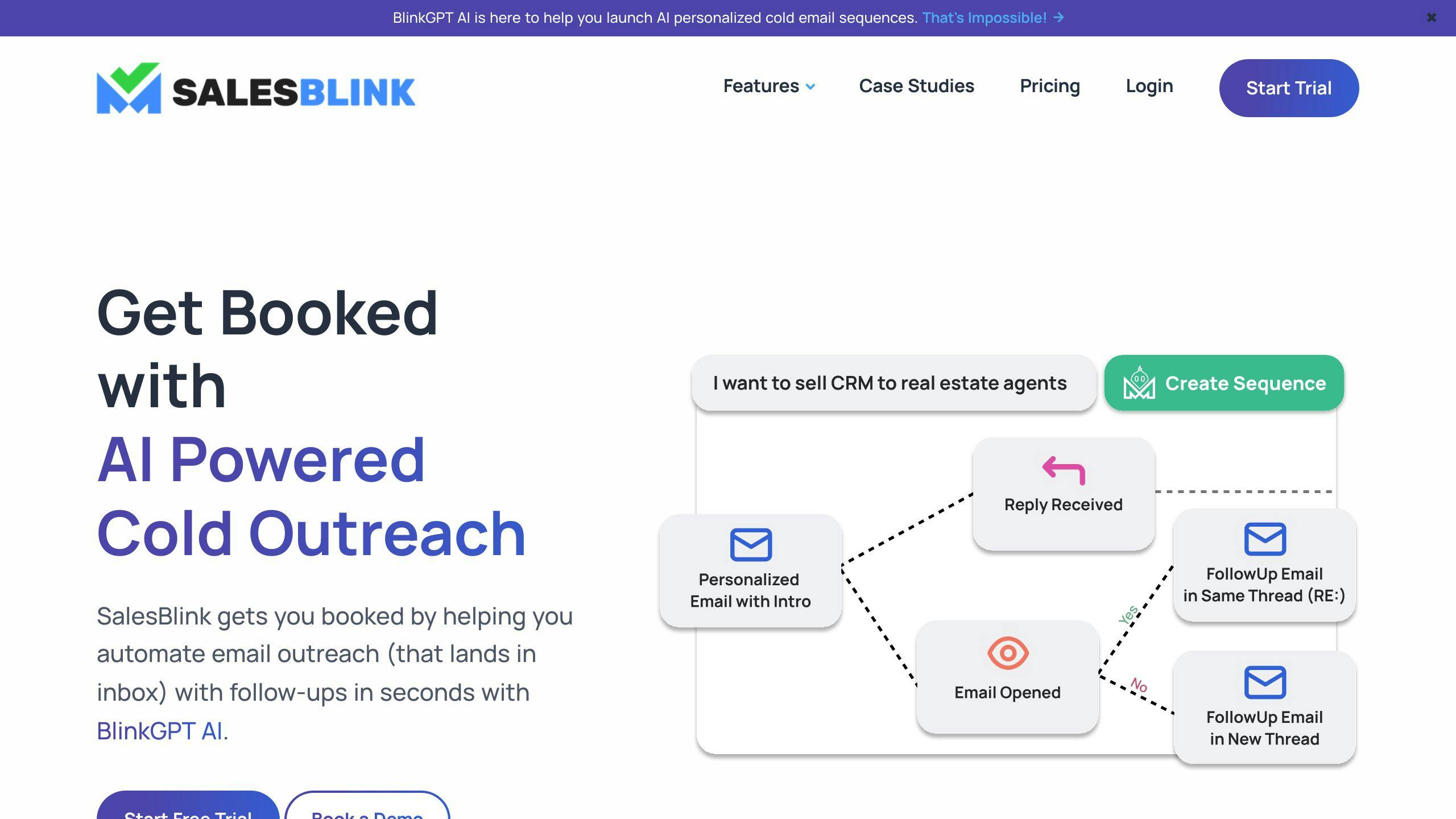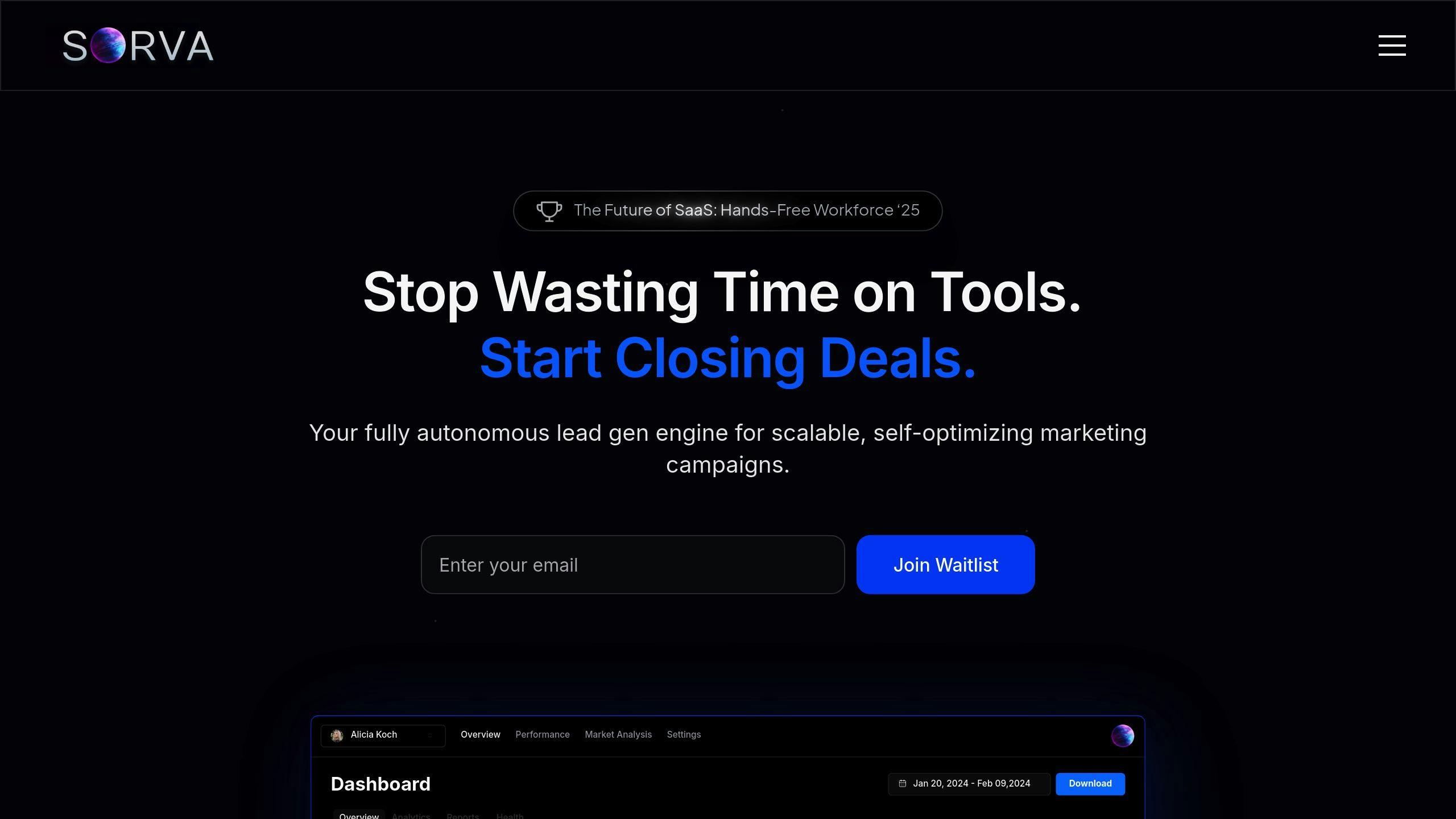
Effective Cold Outreach Techniques for Cybersecurity Firms
Cold outreach is essential for cybersecurity firms looking to grow in a competitive market. But it’s not easy - complex solutions and client skepticism make it challenging. Here’s how to overcome these obstacles and boost your outreach success:
Use AI for Targeting: Tools like Sorva and Demandbase analyze technographic, firmographic, and intent data to identify the right prospects.
Personalized Messaging: Tailor emails to specific industries, referencing real-time threats and compliance needs (e.g., HIPAA, GDPR).
Multi-Channel Approach: Combine email with LinkedIn for higher response rates.
Build Trust Early: Highlight certifications, offer free security assessments, and share case studies with measurable outcomes.
Optimize Timing: Send emails mid-week (9–11 AM) for better engagement.
Write, Automate, and Scale Cold Outreach with SalesBlink's AI

Using AI for Lead Generation in Cybersecurity
AI tools are now transforming how companies identify businesses looking for cybersecurity solutions by analyzing key data streams.
Finding the Right Clients with AI
AI systems focus on three main types of data to pinpoint potential clients:
Technographic data: This shows a company's existing security setup, helping to spot areas that may need improvement.
Firmographic data: This looks at company details like size and industry to determine fit.
Intent data: This tracks online actions that suggest interest in cybersecurity solutions.
Platforms like ZoomInfo and Bombora combine these insights to build detailed profiles of potential prospects. For example, when Crowdstrike implemented Demandbase in 2023, they saw a 78% increase in marketing-qualified leads and reduced acquisition costs by 25% [2].
With such precise targeting, platforms like Sorva can fully automate lead generation workflows, saving time and resources.
Sorva's Automated Lead Generation Approach

Sorva takes a hands-off approach to B2B cybersecurity lead generation. Unlike traditional tools that require constant oversight, Sorva handles everything - from finding prospects to setting up meetings. It focuses on qualified leads while staying compliant with GDPR and CCPA regulations.
Some of Sorva's standout features include:
Automatically identifying companies with emerging security needs
Tailored outreach sequences for specific industries
AI-powered lead scoring
Integration of real-time threat data
Automated checks for compliance with regulations like HIPAA, PCI DSS, and GDPR
Leveraging Real-Time Data for Better Outreach
AI shines when it combines detailed prospect profiles with timely engagement. Three types of real-time data can make outreach more effective:
Trigger events (e.g., downloading a whitepaper): Can boost engagement by 40%.
Sector-specific threats: Help close deals 25% faster.
Competitor activity tracking: Drives a 35% increase in conversions.
Reaching out at the right time, based on active needs, ensures your message is relevant and positions you to address security challenges effectively.
Creating Effective Cold Outreach Messages for Cybersecurity
Once you've identified qualified leads using AI tools, the next step is crafting messages that can turn interest into action.
Key Elements of a Strong Cold Email
Writing cold emails for cybersecurity requires blending technical know-how with clear, concise communication. Use this proven structure to create compelling messages:
Tackling Client-Specific Challenges
Personalization is key to making your outreach resonate. Tailor your message to the unique challenges of the recipient's industry:
Financial Services: Highlight solutions for regulatory compliance and safeguarding sensitive data.
Healthcare: Focus on HIPAA compliance and protecting patient information.
Make your outreach even more relevant by referencing real-time threat data identified through AI tools (as previously discussed). This shows you're addressing immediate risks, not just generic concerns.
Leveraging Case Studies for Trust
Case studies can add credibility to your message. Keep these tips in mind:
Summarize results in 2-3 sentences with clear metrics.
Choose examples that are industry-specific to the recipient.
Include a link to the full case study for those who want more details.
Improving Cold Outreach Campaigns
Cold outreach works best when it's built on a strong foundation of compliance and technical reliability. Sorva's GDPR/CCPA compliance tools, combined with authentication protocols like SPF, DKIM, and DMARC, ensure your emails are trusted. But that's just the start - keeping your email lists clean is equally important for better delivery rates.
Email Deliverability and Timing
When it comes to email outreach, timing plays a major role in engagement. Aim to send emails mid-week (Tuesday to Thursday) for the best results. For example, emails sent during these times show 23% open rates, compared to just 19% for evening sends. Using a dedicated IP address also helps you build a strong sender reputation.
Here's a breakdown of how timing affects engagement:
While good timing helps your emails stand out, combining email with other channels can take your outreach to the next level.
Using Multi-Channel Outreach
Pairing emails with other platforms like LinkedIn can dramatically boost response rates. For example, CyberShield saw a 3.6x increase in responses by combining threat-focused emails with LinkedIn insights about recent breaches.
Here’s an effective sequence for multi-channel outreach:
1. Initial Connection
Kick things off with a LinkedIn connection request. Add a personalized note that highlights the prospect's specific cybersecurity concerns.
2. Email Follow-up
Within 24-48 hours of connecting on LinkedIn, send a detailed email. Use insights from their public company data and any recent security incidents to make the email relevant.
3. Share Threat Analysis
Follow up by sharing a threat analysis report tailored to their infrastructure vulnerabilities. This shows you’ve done your homework and can provide real value.
Monitoring and Enhancing Campaign Performance
Tracking the right metrics is key to improving your cold outreach. Sorva’s engine uses engagement patterns to automatically adjust send times and content, ensuring your campaigns stay effective. Here are some benchmarks to aim for:
Establishing Trust in Cold Outreach
A whopping 86% of IT decision-makers prioritize trust when choosing cybersecurity vendors [1]. This makes credibility the cornerstone of any outreach strategy. To build trust, you need to showcase your expertise while addressing security concerns right from the start.
Showing Expertise in Cybersecurity
Demonstrating authority means sharing insights that directly address your prospects' challenges. Combine AI-driven insights on vulnerabilities with clear trust signals to create a lasting impression.
"In cybersecurity sales, trust isn't just important - it's everything. Your first outreach should immediately convey your expertise and commitment to the prospect's security." - Sarah Chen, VP of Sales at SecureNet, CSO Magazine
Here are key trust-building elements to include in your outreach:
Tackling Security Concerns Early
Addressing security concerns upfront can help ease hesitations. Incorporate GDPR and CCPA compliance into your communication practices to build confidence.
Leveraging Testimonials and Success Stories
Success stories and testimonials can be powerful tools for building trust. Focus on measurable outcomes that align with your prospects' needs. For example, tailor certifications and metrics to match their regulatory requirements, identified through AI insights.
Key Metrics That Matter to Security Buyers:
Conclusion: Streamlining Outreach with AI
Now that we've covered trust-building techniques and ways to fine-tune campaigns, it's time for cybersecurity firms to focus on putting these strategies into action on a larger scale.
Steps to Implement Effective Outreach
1. Assessment and Planning
Review current outreach performance and compare it to industry standards.
Align your lead scoring system with AI-based qualification methods.
Set clear goals for response rates and cost-per-lead (CPL).
2. Technology Integration
Connect your systems with tools like threat intelligence platforms and SIEM systems.
Utilize Sorva's autonomous growth engine to sync directly with your CRM.
Set up data privacy controls to ensure compliance during lead generation.
3. Optimization and Scaling
Run a 60-day pilot campaign targeting financial sector CISOs.
Use the benchmarks from Chapter 4 to identify areas for improvement.
Expand successful strategies to other industry sectors.